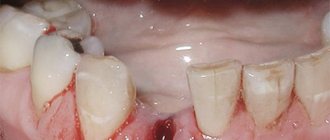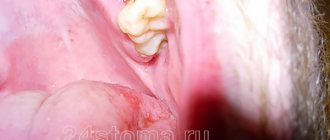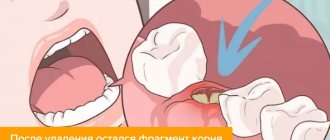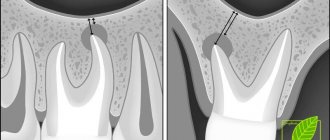Alveolitis is an inflammation of the socket (alveoli) left after tooth extraction. This pathology does not always develop; its development depends on many factors. The disease is characterized by severe pain in the area of the hole formed after surgery, general weakness, fever, headache, enlarged submandibular lymph nodes, bad breath and other unpleasant symptoms.
Alveolitis is not only physically painful, but also a dangerous disease. In the absence of proper treatment for several days, the inflammatory process can result in limited osteomyelitis, purulent melting of the jaw bone, and then surgical intervention will be required again.
With timely diagnosis of pathology and proper sanitation of the socket, the treatment prognosis is favorable. The main thing is to detect the symptoms of the disease in time and begin to treat it.
Classification
Depending on the nature of the healing of the hole, dentists distinguish several main forms of dental alveolitis:
- Serous. The initial stage of the disease usually appears 2–3 days after tooth extraction. This form is characterized by continuous pain that worsens while eating. Although the patient does not yet complain of feeling unwell, his lymph nodes are not enlarged, but he already feels that the disease is progressing.
- Purulent. If the serous form of alveolitis is not treated, the disease turns into a purulent form. Most often it is diagnosed 6–7 days after tooth extraction. The painful sensations can no longer be ignored, the pain intensifies, radiating to the ear or temple. Exploring the affected area also causes severe pain. Purulent alveolitis is characterized by a dirty gray coating inside the socket, significant swelling around the wound, thickened alveolar process and other problems. The patient's general health deteriorates significantly. Lymph nodes enlarge and become painful on palpation. Often the patient cannot even eat or open his mouth.
- Hypertrophic. At this stage, the symptoms of the disease subside. The patient notes a decrease in body temperature, improved well-being and decreased pain. However, at the hypertrophic stage, dangerous tissue proliferation occurs, which is clearly visible upon examination. When touched, pus is released from the inflamed area, and the mucous membrane acquires a bluish tint.
Ask a Question
Lump in the cheek after wisdom tooth extraction
However, patients may complain that the cheek is swollen, there is pain when touched, and the gums have a bluish tint.
Each case is individual. The most likely causes of the pathology are:
- Inflamed lymph node (lymphadenitis) after wisdom tooth extraction. It is characterized by local soreness, tightness in the cheek, and general malaise. Gradually the knot will shrink and become less of a concern. If this does not happen, it is important to consult a doctor.
- Hematoma. Accompanied by cyanosis, it goes away on its own within a few days. Sometimes there is pain, swelling, and fever. In such a situation, the surgeon makes an incision in the gum, washes the wound with antiseptic drugs, and installs drainage to drain the exudate. At the same time, antibacterial drugs and antiseptic rinses are prescribed. If left untreated, a hematoma can provoke phlegmon and an abscess.
- Periostitis (flux). A white ball on the gum filled with pus. Occurs if, after the removal of a wisdom tooth, the wound becomes infected. Microorganisms quickly reached the periosteum and caused an inflammatory process. Symptoms of flux: fever, sharp pain in the area of the extracted tooth, the appearance of a white ball on the gum. Urgent dental care is required to avoid rupture of the purulent sac and infection in the blood.
Causes of inflammation
The disease can develop only after tooth extraction. Most often, the hole formed after removal heals within a day after the operation, and the patient feels better. But if the blood clot that covers the open wound moves or becomes deformed, an infection can penetrate into the hole, in which case alveolitis of the gums develops. As a result, the surface of the wound heals for a long time, and the patient suffers from complex discomfort.
Predisposing factors for the development of inflammation:
- Surgical injuries during complex removal. The more complex the operation, the more pronounced the postoperative inflammation of the bone tissue will be, and the more likely the release of direct plasminogen activators.
- Complex extractions associated with tooth segmentation, osteotomy, detachment of the mucoperiosteal flap. Complex operations increase the chance of developing alveolitis 10 times.
- Removal of wisdom teeth. The denser, less vascularized bone tissue adjacent to the figure eights is prone to the formation of dry sockets.
- General diseases of the patient. Alveolitis often occurs against the background of concomitant diseases. For example, patients with diabetes mellitus or immunocompromised patients are more susceptible to alveolitis due to impaired healing processes in the tissues.
- Taking oral contraceptives. The estrogen contained in these drugs may indirectly enhance the fibrinolytic process, causing the breakdown of the blood clot.
- Smoking. The direct connection between smoking and alveolitis has been repeatedly proven clinically. According to studies, the risk of socket inflammation in smokers increased 4-5 times compared to non-smokers. The incidence increased by more than 20% in patients who smoked 1 pack per day and by 40% in patients who smoked immediately before and after surgery.
- Dislocation of a bunch. If the socket is handled carelessly and there is negative pressure (for example, due to drinking through a straw), alveolitis may develop.
- Bacterial infections. Dentists agree that bacterial infections are the main risk factor for dry socket.
- Poor oral hygiene. The incidence of alveolitis increases significantly with poor oral hygiene.
- Excessive use of local anesthetics. According to some studies, excessive use of an anesthetic with a high concentration of a vasoconstrictor can provoke ischemia and make it difficult for the socket to fill with blood. This condition also increases the risk of alveolitis.
In fact, alveolitis is a fairly rare disease. According to statistics, it affects approximately 3% of patients who have undergone tooth extraction surgery. More often than not, the socket is not formed properly when lower incisors and molars are removed.
But alveolitis is especially common when removing lower wisdom teeth: according to experts, in approximately 20% of cases, the removal of “eights” with difficult eruption is complicated by alveolitis. In addition, it is believed that the risk of developing the disease is inextricably linked with age. This is explained by the fact that metabolism slows down, immunity is weakened, and the regenerative abilities of the body deteriorate.
Causes
The formation of a cyst on the gum after tooth extraction is caused by:
- tissue damage during surgery,
- using a non-sterile instrument,
- disruption of the wound healing process.
The most common cause of pathology is the patient’s failure to comply with medical recommendations. Frequent rinsing of the mouth after tooth extraction, refusal to take antibacterial drugs, poor oral hygiene are risk factors for wound infection. With the active proliferation of pathogenic microorganisms, an inflammatory process quickly develops and a cyst with purulent contents is formed.
Symptoms of alveolitis
As a rule, the patient ignores the first symptoms of inflammation without due attention, considering them to be the norm after surgery. After tooth extraction, as already noted, pain within 24 hours is considered normal. As the hole heals, the pain subsides and completely disappears after a few days.
If the patient develops an inflammatory process, then the unpleasant sensations do not subside after a day or two, and 3–5 days after the operation, severe, throbbing pain in the socket occurs, which intensifies as the infection develops.
With alveolitis, patients may complain of both unbearable and moderate pain. Pulsation and pain are focused, as a rule, only in the removal area. However, in rare cases, the pain radiates to half of the face.
Other characteristic symptoms of alveolitis are:
- a sharp rise in body temperature;
- tooth sensitivity to hot/cold food;
- enlargement of the submandibular lymph nodes;
- decreased appetite;
- increased salivation.
In rare cases, the disease causes weakness, increased fatigue, and secondary infectious foci appear on the oral mucosa.
Symptoms
For a long time, a cyst on the gum, formed after tooth extraction, may not manifest itself in any way. The inflammatory process may also be accompanied by:
- a feeling of heaviness and bursting at the site of tooth extraction,
- swelling of tissues,
- aching pain in the jaw,
- discomfort while eating,
- temperature rise,
- weakness, increased fatigue and other signs of intoxication of the body.
These symptoms cannot be ignored. At the first signs of inflammation after tooth extraction, you should immediately contact a dental clinic. Timely treatment will avoid serious complications - abscess, phlegmon, osteomyelitis, sepsis.
Diagnostics
The main symptom of the disease is the appearance of acute pain, which does not subside either 24 hours or 2–3 days after tooth extraction. Sometimes a dentist can identify chronic alveolitis during routine oral examinations. In this case, an empty socket without granulation tissue appears in place of the impacted tooth. The bone is already visible at the bottom of the hole.
The dentist will be able to determine the presence of tissue changes during the examination; radiography and radiovisiography of the affected area may also be prescribed.
Lump on gum after tooth extraction
We would like to immediately warn you that sometimes complications after tooth extraction occur, no matter what. And it is not always the doctor or the patient himself who is to blame for complications. Although, undoubtedly, the high qualifications and experience of the doctor minimize the risk associated with complications.
If a lump forms on the gum after tooth extraction, this symptom may indicate the presence of inflammation. If the blood clot that usually forms in the hole somehow comes off or does not form at all due to frequent rinsing, then harmful bacteria can enter the wound and cause inflammation. Pieces of food that get into the wound can also inflame the gums. Therefore, dentists usually do not recommend that patients eat in the first few hours after extraction, until the bleeding stops and a blood clot forms.
If you have a lump on your gum after surgery, you should immediately see a dentist, since the inflammatory process requires immediate treatment. Before visiting a doctor, you should never warm the cheek on the side on which the abscess forms, since heat only intensifies the inflammation, making it more intense and fleeting. Cold will help relieve symptoms - you can apply ice cubes to your cheek, previously placed in a plastic bag.
You can’t try to remove a lump on your own! And that's why:
- firstly, only a doctor can correctly diagnose, and what seemed like a lump to you after tooth extraction may actually turn out to be another neoplasm;
- secondly, by removing the lump yourself, you can reinfect the wound, thereby provoking an even more acute inflammatory process!
After a careful examination of the oral cavity, the doctor will make a final conclusion about the causes. If the cause of its formation is an infection introduced into the wound and, as a consequence, an inflammatory process, then treatment will consist of anti-inflammatory therapy. First of all, the doctor will open the resulting lump to release the pus that has accumulated in it. Then rinse the gums with an antiseptic solution to prevent the lesion from spreading. After this, the doctor may also prescribe antibiotics to stop the development of the disease. As an auxiliary therapy, the doctor will recommend rinsing the mouth with antiseptic solutions, as well as decoctions of medicinal herbs.
It should be noted that the occurrence of inflammatory processes and lumps on the gums after tooth extraction occurs, as a rule, in those who have reduced immunity due to a previous disease. Therefore, in parallel with treatment, the doctor will definitely recommend that the patient take multivitamin complexes in order to strengthen the immune system and support a weakened body. It is necessary to follow all the doctor’s recommendations, since only their strict implementation guarantees a quick recovery.
Treatment of alveolitis
When the socket becomes inflamed, the main thing is to eliminate the source of infection, prevent the development of inflammation and preserve the dentition. In order to alleviate the patient’s condition, the dentist uses the following therapy methods:
- Mechanical cleansing of the hole, washing out purulent residues with a solution of nitrofural or hydrogen peroxide.
- Anesthesia of the hole. The pain syndrome is relieved with the help of local applications with anesthetics and analgesics. To do this, the doctor applies the lotion for half an hour and then removes it to prevent the proliferation of microbes in the area. The dentist will advise the patient to repeat the procedure several times a day. Taking painkillers orally is not recommended.
- Taking antibiotics. In the presence of concomitant diseases, alveolitis is treated with antibiotics.
With the right approach, the signs of alveolitis subside 2-3 days after the start of treatment. If therapy was not started on time, residual pain may drag on for 2–3 weeks.
With the permission of the dentist, additional treatment of alveolitis with folk remedies is possible:
- Sage rinses. To prepare the solution, brew a large spoonful of dry sage in 250 ml of boiling water, leave the mixture for an hour, wrapping the container in a towel. After this, the liquid should be filtered and used for rinsing.
- Gargling with chamomile flowers. To prepare the composition, brew a large spoonful of chamomile flowers in a glass of water for 15 minutes, insulating the container with a towel. The infusion should be strained and rinsed your mouth up to 12 times a day.
- Poplar buds. To prepare, take half a glass of buds, pour into a glass container and pour in 500 ml of vodka. The product should be infused for 10 days in the dark and cool, then filtered, soaked in cotton swabs and applied to the inflamed area.
- A soda rinse solution can also be an effective addition in the treatment of alveolitis. You should take a large spoonful of powder in a glass of warm water or mix soda with water to obtain a paste-like mass, which then needs to be used to treat the hole.
- Burdock leaves. To prepare a medicinal decoction of burdock leaves, you need to pour 20 grams of raw material with 2 glasses of water, and then simmer the mixture over low heat for about 40 minutes. The resulting solution should be cooled and filtered, and then used for rinsing.
- Aspen bark. Pour 1 tablespoon of crushed aspen bark into one glass of boiling water. It is important to leave the solution in an airtight container for 3 hours, and then use 100 ml of strained warm liquid at least 3 times a day.
- Anise infusion. To prepare the infusion, pour 1 tablespoon of anise into 200 ml of boiling water, and then keep in a thermos for 50 minutes. The liquid should be filtered and used to rinse 3 times a day.
Prevention
The best prevention of pathology after tooth extraction is to be attentive to yourself and follow all the surgeon’s recommendations. While the hole is healing, give up bad habits, eating too hot, spicy, sweet foods, and if possible, switch to pureed foods. And if you suspect inflammation, contact your dentist as soon as possible.
Under no circumstances should the first symptoms of alveolitis be ignored. Against the background of inflammation, more serious problems may arise:
- Phlegmon is an acute diffuse purulent inflammation.
- An abscess is a purulent inflammation of tissues with their melting.
- Osteomyelitis is a purulent-necrotic process that can develop in the bone and bone marrow, as well as in the surrounding soft tissues.
- Periostitis is inflammation of the periosteum.
- Sepsis is a severe systemic inflammatory reaction.
- Tissue necrosis is local tissue death.
Modern methods of treating alveolitis make it possible to quickly relieve the symptoms of inflammation and avoid the complex consequences of the disease. The sooner the patient consults a doctor, the less likely it is to develop complications.
Treatment of alveolitis in STOMA clinics
Surgeons at STOMA clinics are required to examine patients and give recommendations on how to care for the hole formed after tooth extraction. If problems arise after extraction, the patient can always call the clinic and clarify whether inflammation has really begun and what to do to reduce pain.
At any time after removal, the patient can contact our clinics. The attending surgeon will examine him and prescribe appropriate therapy.
Feel free to call us at any time and consult about your condition. The sooner we start treating alveolitis, the lower the risk of complications.
Treatment methods
Treatment of inflammation of the periosteum after tooth extraction is carried out using different methods - conservative and surgical. The choice of tactics depends on the severity of symptoms and the general condition of the patient.
Drug support is prescribed at an early stage of the disease. It consists of taking antibiotics, anti-inflammatory drugs, antihistamines and painkillers.
To achieve optimal results, in most cases, drug therapy is combined with surgical treatment methods. Under anesthesia, the dentist opens the source of inflammation, ensures the outflow of purulent contents through drainage, and excises necrotic tissue.
Physiotherapy can normalize the condition of the damaged periosteum. UHF, laser therapy, electrophoresis, hydromassage and other techniques can speed up the regeneration of bone tissue and mucous membranes.











